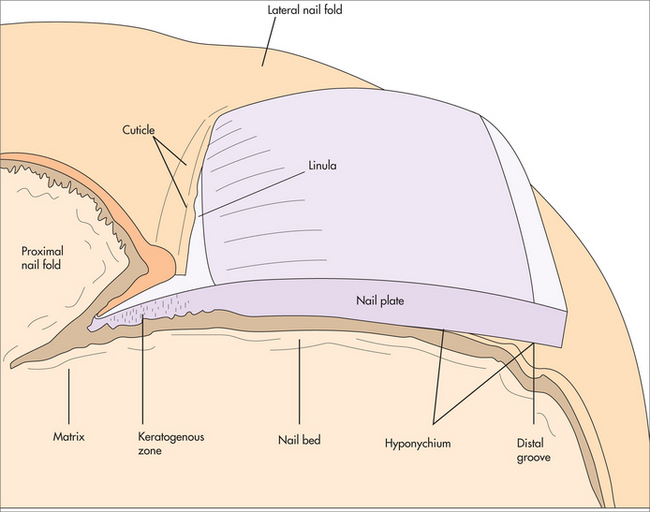chapter 35 Nails
NORMAL NAIL STRUCTURE
The normal nail structure consists of the nail matrix, the nail bed, the proximal and lateral nail folds, the cuticle and the nail plate (Fig 35.1). The nail matrix is made up of the germinative epithelium, and is protected from the environment by the waterproof seal created by the cuticle.
COMMON NAIL PROBLEMS
HYPERTROPHY AND SUBUNGUAL HYPERKERATOSIS
Onychomycosis (fungal infection)
Onychomycosis is a relatively common nail disease. A recent European study (Achilles) of 90,000 people aged over 60 years in 16 countries estimated that half had a ‘fungal foot infection’ and that one-quarter of these had onychomycosis.1,2 An Australian study of the general population stated the prevalence as 2–8%, but this figure increases with age.3 An Australian nursing home study put the rate at 22%.4
Diagnosis
A diagnosis of onychomycosis should be made before embarking on treatment. Many diseases mimic onychomycosis. Unfortunately, using fungal microscopy and culture, a negative result is obtained in about 40% of cases where infection is truly present. Ideally, when sending a specimen for micro and culture, plenty of the subungual material should be collected and ground up before plating. Distal nail biopsy gives a much higher yield of positive results. Basically this involves cutting off as large a specimen as possible of distal nail (in fact the patient often does this best, and you must stop the nail clipping being lost over on the other side of the room). The piece is sent for histopathology as well as micro and culture, and the pathologist looks for hyphae in the nail plate.
Treatment
Psoriasis
Involvement of the fingernails and toenails with psoriasis has been reported in up to 50% of psoriasis sufferers.5 The fingernails are more commonly involved than the toenails.
Treatment
No treatment is fully effective in all people, and often the patient opts for no treatment.
CHRONIC PARONYCHIA
Treatment
ONYCHOLYSIS
Treatment
BRITTLE NAILS
Causes
Many factors are associated with brittleness, but water is probably the most important. Repeated wetting and drying has been shown to lead to the above changes. Other chemicals, cement, detergents and alkalis can also lead to dissolution of intercellular adhesive factors and thus to brittle nails.
SINGLE NAIL DEFORMITY
Diagnosis often requires surgical exploration (after X-ray), and treatment is by surgical excision.
SYSTEMIC DISEASE
CLUBBING
Eighty per cent of cases are associated with pulmonary disease, especially chronic infections and cancers.4 Other associations include endocarditis, bowel diseases, Graves’ disease and systemic lupus erythematosus.
NAIL CARE
PRE-FORMED ARTIFICIAL NAILS (FALSE NAILS)
Artificial nails are plastic devices glued onto ‘normal’ nails to make them look longer and more beautiful. The nail plate is roughened by a file to increase adhesion, and a glue, usually ethyl cyanoacrylate, is used. This may cause allergic contact dermatitis, so these nails should not be worn for more than 48 hours at a time.
1 Haneke E. Achilles foot-screening project: background, objectives and design. J Europ Acad Dermatol Venereol. 2006;12(S1):S2-S5.
2 Roseeuw D. Achilles foot-screening project: preliminary results of patients screened by dermatologists. Eur Acad Dermatol Venereol. 2006;12(S1):S6-S9.
3 Gill D, Marks R. A review of the epidemiology of tinea unguium in the community. Aust J Dermatol. 2002;40(1):6-13.
4 Tosti A, Piraccini BM, Mariani R, et al. Are local and systemic conditions important for the development of onychomycosis? Eur J Dermatol. 1998;8(1):41-44.
5 Baran R, Dawber R, de Berker D, et al. Baran & Dawber’s diseases of the nails and their management, 3rd edn. Oxford: Blackwell Science, 2001.






